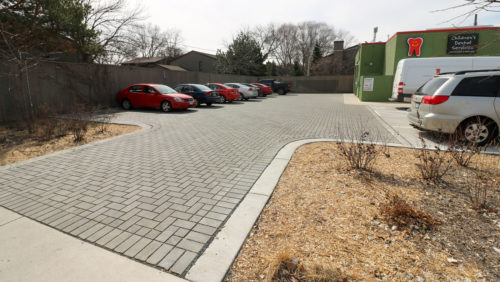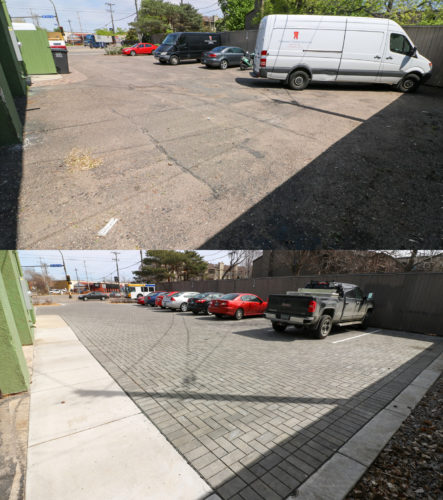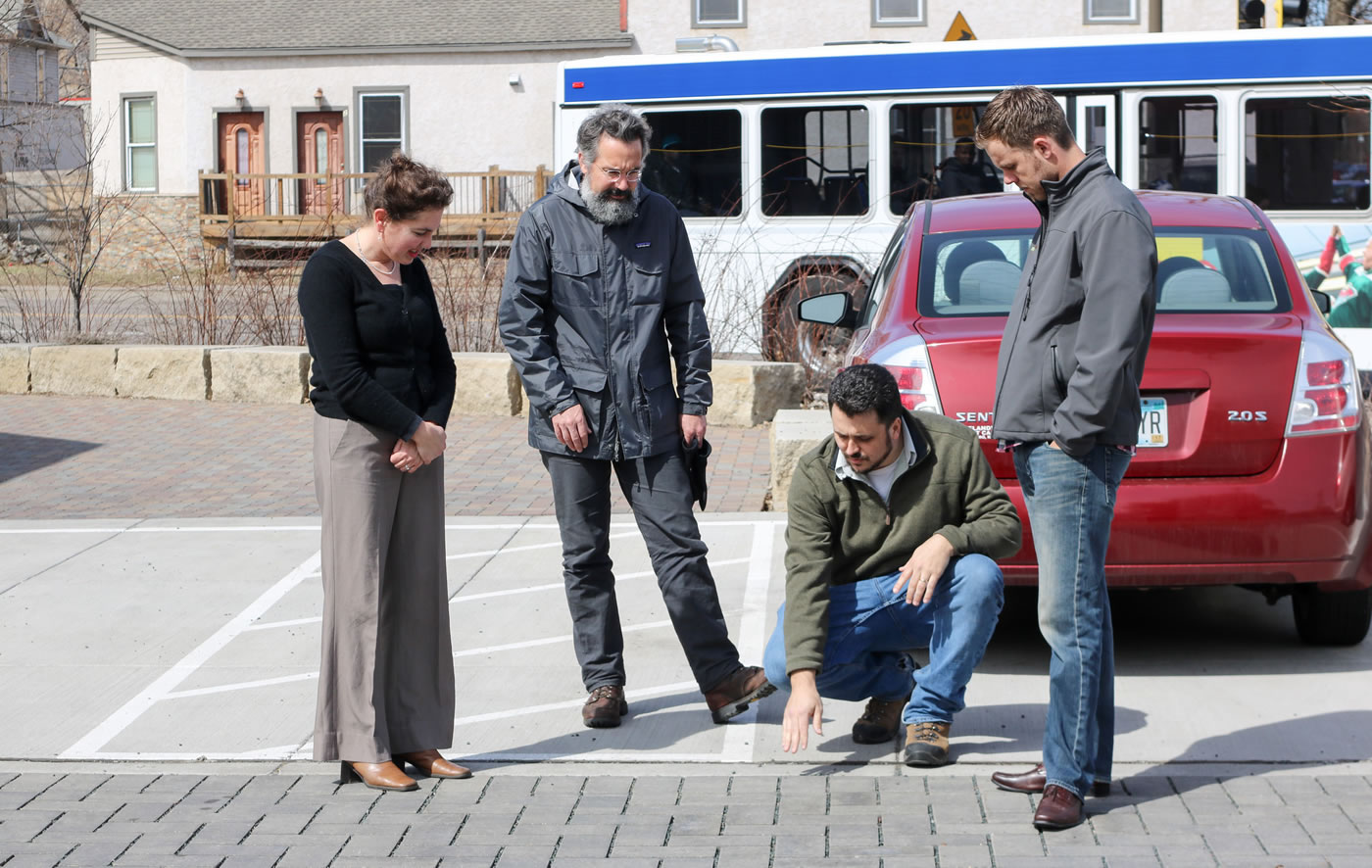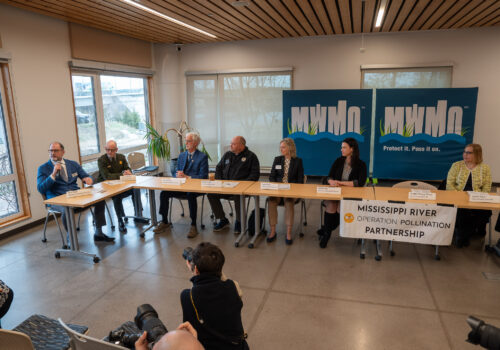
News / April 03, 2017
From eyesore to eye-catching, nonprofit’s new parking lot fights pollution
To some, fixing a worn-out parking lot might not seem an obvious way to strike a blow for environmental justice. But Children’s Dental Services is an organization that thinks big. So when it came time to tear up the pavement at their newest clinic, the nonprofit dental care provider went above and beyond.
Working with a team of environmentally minded designers and contractors (and with the help of MWMO grant funding), CDS replaced its decayed asphalt parking lot with 4,200 square feet of permeable pavers. The new eye-catching, stormwater-absorbing landscape helps keep pollution out of the nearby Mississippi River. It also furthers the organization’s goal of improving the health of underserved communities.

“It has been a core value of CDS to integrate environmental sustainability in its operations,” said Executive Director Sarah Wovcha. “If we’re interested in children’s oral health because of the impact that it has on their overall health and well being, we have to be aware of the broader impact that we have on the environment in which they live, work and play.”
Wovcha calls the parking lot the “capstone” in a series of eco-friendly renovations at their new East Hennepin Avenue clinic. CDS worked with Alm Design Studio to upgrade the former service station with solar panels, extra insulation, high-efficiency lighting, natural flooring, nontoxic paint and other improvements.
For Wovcha and CDS, being environmentally conscious isn’t just an end in itself; it supports their goal of improving the lives of disadvantaged populations.
“Ultimately, the people who suffer the most from environmental degradation tend to be disenfranchised, underserved communities,” Wovcha said. “We want the families we serve to be aware and be empowered to take charge of their health,” she said.
Permeable pavers as a stormwater solution
The clinic’s site plan called for a redesigned parking lot that would reduce stormwater runoff from the property. Lucas Alm, who engineered the building renovations, reached out to designer Sam Geer of Urban Ecosystems, LLC, to work on the final design and construction.

After looking at several options, the team settled on pavers because they were the most efficient and had the greatest potential for storing captured stormwater runoff. Geer said pavers are ideal for such a small site with no good options for vegetated drainage like rain gardens or swales.
“It’s a pretty small, compact urban site,” Geer said. “We really didn’t have a lot of room to put water off of some of the paved surfaces that were present on the site, so that made permeable paving systems really a good option.”
Permeable pavers work by allowing stormwater runoff flow into gaps between the pavers. The water then drains through a series of base layers made up of varying sizes of stone before it finally soaks into the ground. If the ground becomes too saturated, the stone acts as a reservoir, holding the water until it finally infiltrates into the soil beneath.
The paver system at CDS is designed to capture all of the site’s runoff for an estimated 95 percent of storm events, including from the building’s roof and other impervious surfaces. Previously, runoff from the site flowed directly into a nearby storm drain and out to the river. By managing stormwater on site, the paver system traps pollutants like sediment and phosphorus that would otherwise flow to the river.
“The goal was very much to create a stormwater management system that would catch every drop of stormwater that fell on the site,” Geer said. “It’s designed with a 10-year, 24-hour storm event in mind.”
The team had a lucky break with regard to the underlying soil. Borings revealed that the site was built on a sandy subgrade that was ideal for infiltrating stormwater. This meant that the project could be completed without the need for an underdrain that connects to the city stormsewer — something Geer said might have added $30,000–$40,000 to the project cost.
To install the new parking lot, the team chose Nelco Landscaping, which specializes in eco-friendly landscape designs. Owner Brian Nelson was instrumental in crafting the final paver design, which he had recreated from a design he saw at Macalester College. Belgard manufactured the pavers, while Hedberg Aggregates supplied the other construction materials.
The completed system uses 450 cubic yards of granite stone base layer divided into two separate cells beneath the pavers. A six-inch underground berm divides the cells, allowing water to be held on the northern half of the lot before it overflows into the southern cell, thus adding to the overall storage capacity.
Making friends with the neighbors
The project stretched out over three years, during which time the team utilized three separate MWMO Stewardship Fund grant. A Mini Grant funded soil testing and analysis; a Planning Grant funded the design; and an Action Grant helped fund the construction. A total of $61,885 of MWMO funding was used for the project, without which Wovcha said the project might not have happened.

“It is financially a challenge for us to affect this kind of sustainability on our own,” she said.
Wovcha said one of the goals for the project was to create a welcoming space for the community. The site is located on a highly visible corner in Northeast Minneapolis, with a bus stop directly in front of the building. The project has improved both the aesthetics of the neighborhood as well as relations with the neighbors.
“The site, before we purchased it, was really disheveled,” Wovcha said. “We went around to the neighbors at each stage of the project to let them know when there will be construction vehicles and interruptions in parking and things like that, and they just are so accommodating and thrilled to see these improvements.”
With a large apartment complex next door, Wovcha said the neighbors appreciate the aesthetic benefits as well as the environmental benefits of the project. CDS is considering installing interpretive signage at the site to explain the stormwater features to visitors and passersby.
“The reaction has been really positive. We’ve received amazing ‘oohs’ and ‘aahs’ about how beautiful the permeable paver lot is,” she said.
Geer, the project designer, teaches a landscape architecture class at the University of Minnesota. He brought a group of his students out for a field trip last fall while the site was still under construction and gave them this tour:


